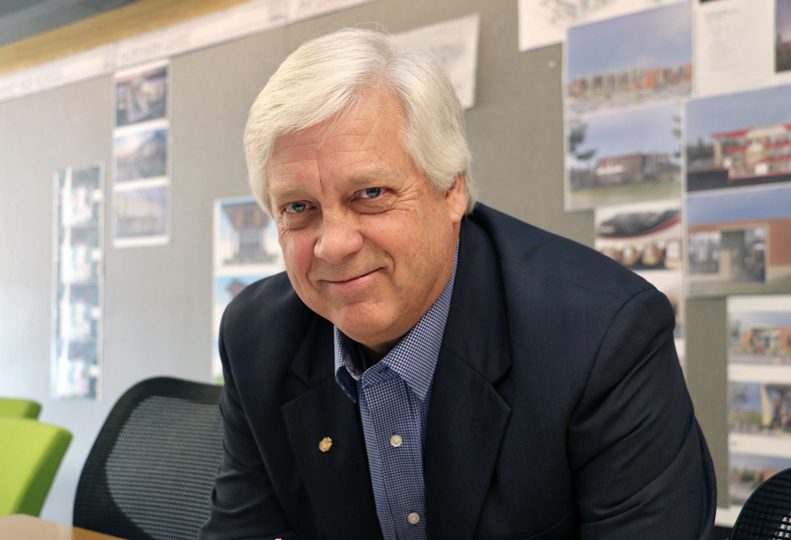
Home » Huotari tackles architect shortage in larger AIA role
Huotari tackles architect shortage in larger AIA role
Industry veteran is in first year of three-year stint

November 9, 2017
David Huotari, a partner at Spokane-based ALSC Architects PS, says an improved economy has helped to unveil a shortage of architects in the U.S.
Like many other professions associated with the real estate and construction sectors, the architectural industry is confronted with a lack of young professionals to replace veteran architects, one of the industry’s biggest challenges.
“Where do the future architects come from?” Huotari says rhetorically. “Baby boomer architects are retiring, so the trend we’re seeing is that there are more going out than coming in.”
In addition to being a partner at ALSC, Huotari is about to wrap up his first year as the regional director of the American Institute of Architects Northwest & Pacific Region.
Huotari was elected as AIA regional director at the beginning of 2017, which marked the first year of a three-year term.
He’s serving in that capacity alongside AIA senior director Chere LeClair, of AIA Montana. LeClair is a professor at Montana State University’s College of Arts and Architecture.
The AIA Northwest & Pacific Region includes Washington, Idaho, Montana, Oregon, Alaska, Guam, Hawaii, and Micronesia. With more than 5,700 members, AIA Northwest spans the largest geographic region among nearly 20 AIA regions across the U.S., Huotari says.
Founded in 1857, the AIA, which is based in Washington, D.C., has a combined membership of 90,000 architects. The organization serves its members with professional development opportunities and takes an active role in educating the public about the role architecture plays in society, Huotari says.
Part of Huotari’s role as regional director also involves serving on AIA’s national strategic council.
“We serve as a conduit between the national organization and the regional (organizations) informing members about trends, practices, and challenges facing the industry,” Huotari asserts.
Huotari says the Great Recession accelerated the departure of veteran architects who decided to either leave the profession altogether or retire.
“The economy has picked back up, but there just aren’t the bodies that there were once were to handle the demand,” he says.
Also, unlike previous years, young, aspiring architects are being recruited to other industries, specifically the entertainment industry.
“Mapping environments digitally, 3-D and virtually technologies are skillsets that lend themselves to Pixar, Disney, Sony, and Nintendo,” Huotari says.
“Those companies value those transferrable skills. They pay a lot, and they didn’t see a slowdown in business when the economy was bad,” he says. “They have the ability to provide a different level of stability.”
In response, AIA here, and its national chapters, are looking to enhance their existing education and outreach programs to both school-aged students and the general public about the architecture industry, Huotari says.
Every April, AIA’s Spokane chapter hosts Architecture Week at River Park Square. The goal has been to offer K-12 students exposure to the architecture industry.
“It’s part of a national initiative that’s intended to connect with kids, and it’s not necessarily with the desire to recruit students to the field,” he says. “We want to show them what it means to be an architect and give them enough information to have an appreciation for the field.”
Huotari, 57, grew up in the Freeman community south of Spokane and continues to make it his home. He spent two years at Spokane Falls Community College and then earned his bachelor’s degree in architecture from the University of Idaho in 1983.
Huotari now sits on the advisory board of the UI’s College of Arts and Architecture, he says.
He says his interest in becoming an architect stemmed from doing construction work with his father when he was a boy.
“I was the oldest son so that automatically made me his construction crew,” he says of his father, Leroy Huotari, who is now 84. “I really enjoyed the process of wondering and learning how things fit together. If I weren’t an architect, I’d probably be in some form of construction.”
From Freeman, Huotari says he’s able to spend just as much time in the Spokane office as he can in the North Idaho office.
ALSC, founded in 1948 by Tom Adkison and Royal McClure, hired Huotari in 1986. He became a partner in the firm in 2000.
ALSC’s Spokane office is located downtown at 203 N. Washington, on the fourth floor of the Liberty Building. The firm occupies the entire 16,000-square-foot floor. The firm also has a 1,200-square-foot office at 6500 Mineral Drive, in Coeur d’ Alene.
ALSC has 38 total employees, with three of those employees working in the North Idaho office.
“In my time at ALSC, we’ve been as high as 55 (employees) and been as low as 32,” he says. “What we’ve learned through the years is that the sweet spot for us is 40 to 45 employees.”
Huotari says ALSC doesn’t measure its success based on the size of its staff.
“The quality of the design work and the relationships we have with clients are what we believe determines our success,” he says.
“We have a longstanding engagement with Spokane,” Huotari says of ALSC. “We’re a very community-minded firm.”
Latest News Up Close
Related Articles



